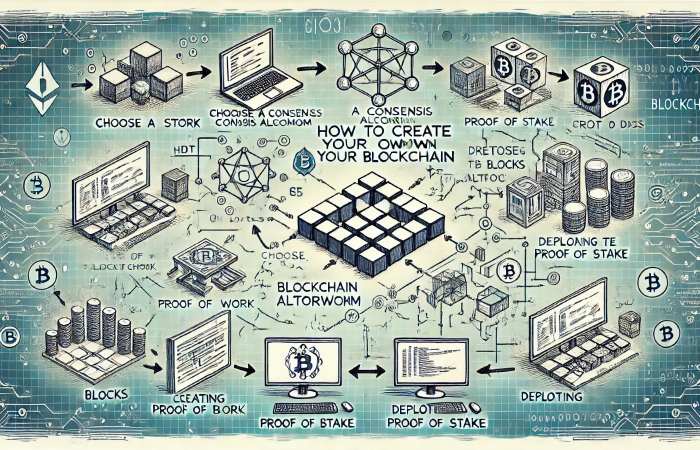In the fast-developing world of blockchain technology, unique architectures offer a glimpse into the future of decentralized applications and systems. At the forefront of this innovation is the Casper’s Blockchain, a platform that stands out for its modular approach. Understanding what makes Casper a modular blockchain is crucial to accepting its potential impact on the industry. This innovative design improves flexibility and scalability and paves the way for more efficient and customized blockchain solutions, marking a significant step forward in the quest for large-scale blockchain adoption.
The article explores the complexities of Casper’s methodology, its modular design’s foundations, and its various benefits. When Casper has a modular blockchain, readers will learn the unique characteristics distinguishing this platform from conventional blockchain systems.
Additionally, the application of Casper technology will be deployed in real world scenarios, demonstrating its versatility and potential to revolutionize various sectors. Throughout this exploration, the article aims to provide an integral understanding of the Casper modular blockchain and its importance in the panorama of the blockchain.
Understanding Casper’s Modular Design

Definition of Modularity in Blockchain (Casper’s Blockchain)
Modularity in blockchain technology refers to dividing a system into different parts or modules, each complementing specific functions. This concept allows for module specialization and optimization, improving overall system efficiency and evolution.
Modular blockchains, such as Casper, are composed of several compartments that determine data availability, consensus, regulation, and execution so that they can function efficiently in the respective domains.
The Structure of Casper’s Modules (Casper’s Blockchain)
Casper’s modular design is characterized by its compartmentalization into several vital layers:
- Data Availability Layer: Ensures that all transaction data is accessible to nodes on the network.
- Consensus Layer: Nodes agree on the current state of the blockchain and validate transactions.
- Settlement Layer: Transactions are irreversibly recorded on the blockchain.
- Execution Layer: Manages transaction execution, mainly for smart contracts.
This structure allows each layer to focus on its specific function, improving performance and scalability.
Comparing Modular vs. Monolithic Blockchains
Modular blockchains differ significantly from monolithic blockchains, which integrate all functions into a single layer. Monolithic designs provide high security and decentralization but often lack flexibility and scalability.
In contrast, modular blockchains like Casper offer improved scalability and efficiency by specializing and optimizing each layer. However, this can sometimes lead to increased complexity and potential security vulnerabilities in multi-layer transactions and bridging functionality.
The Benefits of a Modular Blockchain

Enhanced Scalability
Modular blockchains significantly improve scalability by separating core functions, such as execution, settlement, data availability, and consensus, into separate layers.
This separation allows each layer to optimize processes and handle more transactions without saturating the system. For example, by moving computation off-chain, transaction throughput can increase by 10 to 100 times, solving the scalability trilemma.
Customization and Flexibility (Casper’s Blockchain)
Blockchain’s modular architecture provides unparalleled customization and flexibility. Developers can select and integrate specific modules tailored to their project’s needs without rebuilding the entire blockchain.
This ability to modify consensus mechanisms, integrate smart contracts, or enable cross-chain interoperability fosters a dynamic ecosystem of custom blockchains, enhancing developer freedom and innovation.
Future-Proofing Through Easy Upgrades
Modular blockchains facilitate upgrades by allowing individual components to be upgraded independently without disrupting the entire network. This modular approach minimizes downtime and reduces the risk of system failure, ensuring that the blockchain infrastructure remains robust and adaptable to future technological advancements.
Casper’s Unique Modular Features

Casper’s blockchain technology is distinguished by its innovative approach to modularity, as demonstrated by the flexibility of its consensus layer, the network’s interoperability capabilities, and customizable execution layers designed for diverse applications. This section examines the unique modular features that make Casper a pioneering force in blockchain.
Consensus Layer Flexibility (Casper’s Blockchain)
At the heart of Casper’s architecture is its proof-of-stake consensus mechanism, designed to provide world-class security, scalability, and energy efficiency. This foundational layer supports seamless asset transfer and cross-platform interactions, driving innovation and growth. Unlike traditional blockchains, Casper allows for changes and upgrades within the consensus layer without disrupting the network, demonstrating unparalleled flexibility.
Interoperable Networking Capabilities
Casper excels at building bridges between different blockchain networks, improving trust and transparency in the decentralized landscape. Through strategic partnerships, such as with IBM, and adopting technologies like the Ferrum Cross-Chain Bridge, Casper is expanding its reach to multiple platforms, including Polygon and Binance Smart Chain. This interoperability facilitates cross-chain asset transfers and liquidity and pushes Casper to become a central hub of the blockchain ecosystem.
Customizable Execution Layers for Diverse Applications
The Casper blockchain execution layer is where transactions and smart contracts are processed. Separating this layer from the consensus module allows for faster transaction speeds and lower costs, suitable for a wide range of applications from supply chain optimization to decentralized finance (DeFi). Additionally, Casper’s integration with WebAssembly (Wasm) allows developers to use popular programming languages, improving the blockchain’s adaptability and usability to create custom solutions tailored to specific business needs.
By leveraging these modular features, Casper addresses the scalability trilemma and paves the way for a future where blockchain technology seamlessly integrates with emerging technologies such as AI and IoT. This visionary approach underscores Casper’s commitment to fostering a versatile and efficient blockchain environment that supports innovation and growth.
Real-World Applications of Casper’s Technology

Financial Services and Cryptocurrencies
Casper’s blockchain technology is significantly revolutionizing the financial industry by improving data security and automating systems using smart contracts. Recognizing the potential of blockchain technology, large financial institutions have adopted it to protect data and optimize cash flow management. Casper enables these institutions to seamlessly execute cross-border transactions with the same efficiency and cost, regardless of geographical distances. This speeds up payments and facilitates lending and borrowing directly between users, bypassing traditional intermediaries.
Supply Chain Management Improvements (Casper’s Blockchain)
Casper Blockchain offers robust solutions for supply chain management, ensuring transparency and efficiency. It enables real-time tracking of products from production schedules to delivery, ensuring that all stakeholders have access to accurate, tamper-proof data. This level of transparency helps prevent communication errors that could lead to shipping delays or inventory issues. Additionally, Casper smart contracts automate transactions such as ordering and invoicing, improving decision-making and reducing costs. In particular, companies such as WISeKey are using the Casper blockchain to protect critical assets, demonstrating the practical application of this technology in managing complex supply chains.
Enhancing Security within the Healthcare Sector (Casper’s Blockchain)
In healthcare, Casper’s blockchain technology ensures the security and confidentiality of medical data thanks to its decentralized and immutable nature. It enables healthcare providers to manage patient data securely, giving them control over their medical records. This technology also facilitates the secure exchange of data between different stakeholders, thereby improving collaboration and efficiency in the delivery of healthcare services. Additionally, blockchain’s ability to authenticate medications and track medical supplies from manufacturers to patients improves supply chain integrity, essential for patient safety and regulatory compliance.
Conclusion
Through exploring the Casper blockchain, it becomes clear that its unique modular approach sets a new standard for flexibility, scalability, and efficiency in the blockchain landscape. A detailed look at its structure, from consensus and data layers to execution and interoperability features, highlights the platform’s potential to drive innovation and solve long-standing challenges in blockchain technology. The implications of such a design are far-reaching, providing a model for future developments in decentralized systems and pushing the boundaries of what blockchain architectures can achieve.
Furthermore, real-world applications of Casper technology in finance, supply chain management, and healthcare highlight its ability to revolutionize industries by providing secure, efficient, and interoperable blockchain solutions. Casper’s approach addresses the scalability trilemma and paves the way for a future where blockchain seamlessly integrates with diverse technologies, fostering an ecosystem where innovation, security, and efficiency merge. Looking ahead, the impact of Casper’s modular blockchain on the broader technological landscape promises transformative change, highlighting the importance of continued exploration and adaptation in blockchain development.
FAQs
What Distinguishes Casper’s Blockchain as Modular?
Casper’s blockchain is distinguished by its modular architecture, which contrasts with the traditional monolithic setup of blockchain services. By separating transaction processing. Consensus mechanisms, and data storage into distinct layers.
Why is Blockchain Technology Considered Unique?
Blockchain technology is unique because it uses a distributed ledger system, replicating and storing transactions and data in multiple locations simultaneously. Participants with the necessary permissions can access the same transparent information in real time. Ensuring immutability and transparency.
What Makes Each Block in Blockchain Technology Unique?
In blockchain technology, the uniqueness of each block is assigned to a distinctive identifier called a “hash.” This alphanumeric string acts as the block’s fingerprint, allowing transactions on the blockchain to be verified.


